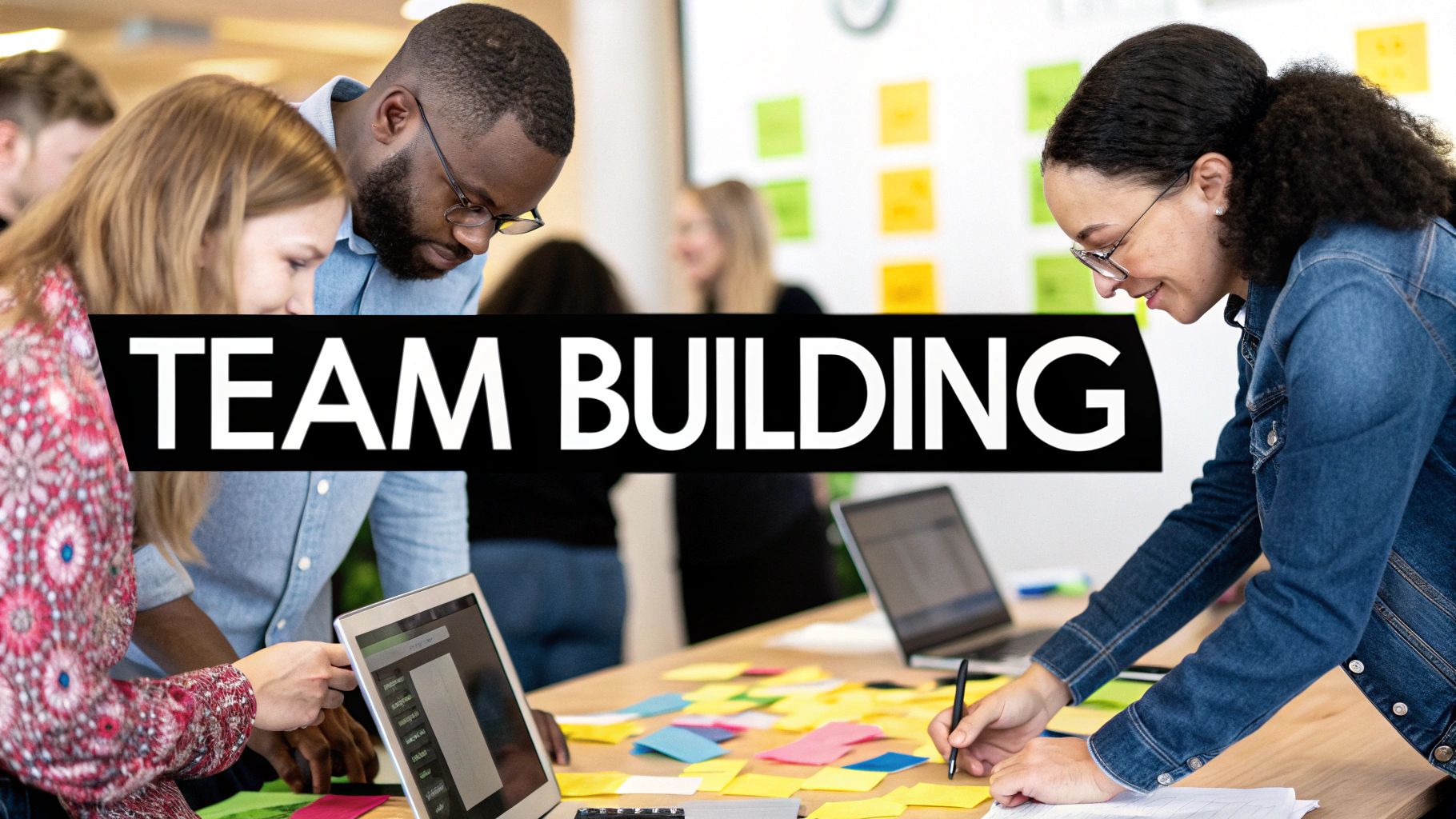A team building workshop is more than just a company-sponsored pizza party. It’s a structured event, a dedicated time-out from the daily grind, where a team can focus on improving how they work together through specific activities and exercises. The goal isn't just to hang out; it's to tackle specific objectives like strengthening collaborative skills, boosting morale, or getting new hires up to speed with the team's culture.
Why Team Building Workshops Actually Matter
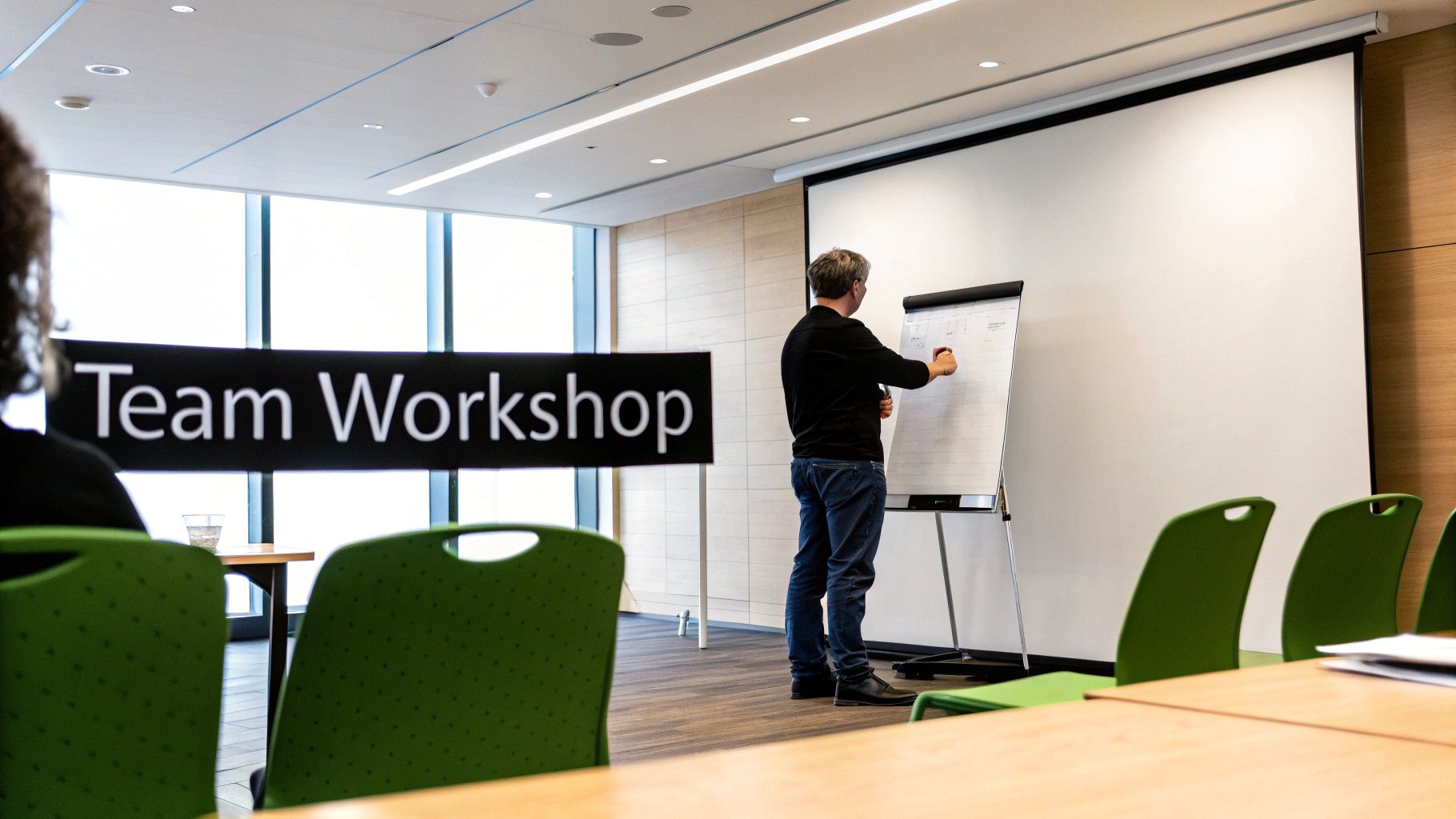
Let’s be honest, the term "team building" can sometimes make people cringe, bringing back memories of awkward icebreakers and forced fun. But a modern team building workshop is a world away from that. It’s a strategic business tool, not just a feel-good perk. Think of it as a direct investment in your company’s most valuable asset: your people.
When you get it right, a great workshop creates a ripple effect that touches everything from daily workflows to long-term profitability. That's why companies in fast-paced industries like tech and healthcare are weaving team building into their core strategy. They know that a tight-knit team built on trust is better at innovating, solving tough problems, and rolling with the punches. This isn't just about good vibes; it's about building a resilient, high-performing workforce.
✦The Real-World Impact
The payoff from a well-run workshop doesn't end when everyone logs off or leaves the room. The skills, insights, and relationships built during these sessions carry over into the everyday work environment, making a real, tangible difference.
Here’s what that actually looks like:
- Communication Gets Clearer: Workshops create a safe space for people to practice real dialogue and active listening, which helps tear down the communication silos that kill projects.
- Productivity Jumps: It’s simple. When people trust each other and know who’s good at what, they work together more smoothly. That means projects get done faster and the quality of the work goes up.
- People Stick Around: Investing in your team’s development and relationships sends a clear message: we value you. That boost in morale and loyalty is huge for retention.
- Problems Get Solved Faster: Creative team activities push people to think differently and attack challenges from new angles—a skill that’s priceless when the unexpected happens at work.
✦A Growing Strategic Investment
Companies are putting their money where their mouth is. Across major industries, we're seeing budgets for employee engagement and collaboration initiatives climb.
For instance, a whopping 90% of tech leaders are planning to spend more on these kinds of activities. The U.S. healthcare sector is looking at a 7.7% increase in workforce development spending, and 77% of CFOs in finance are projecting bigger budgets for engagement tools. The trend is clear.
One of the biggest drivers for running a workshop is to create a more connected team and equip them with practical techniques for improving team collaboration.
By investing in these collaborative skills, you're setting your team up to thrive no matter where they work—remote, hybrid, or in the office. It all comes down to building a foundation of trust and mutual respect that pays off long after the workshop is over.
Setting Your Workshop Up for Success
A great team-building workshop doesn't just happen by magic. It’s the direct result of thoughtful planning that starts long before anyone logs into a video call or steps into a conference room. Getting this foundation right is what separates a truly memorable event from an afternoon that feels like a waste of everyone's time. The very first thing you need to do is get laser-focused on what you actually want to achieve.
Are you trying to iron out some communication wrinkles between two departments that just aren't clicking? Or maybe you've got a fresh batch of new hires you want to welcome into the company culture. It could even be as simple as giving everyone a well-deserved morale boost after a grueling quarter. Whatever it is, that objective becomes your North Star—it guides every single decision you make from here on out.
✦Defining Clear Goals and Objectives
Without a specific goal, your workshop is just… an activity. A vague aim like "improving teamwork" is almost impossible to measure and often leads to generic, ineffective exercises. You need to think in terms of tangible outcomes.
Let’s get specific:
- For Communication: "Our engineering and product teams will leave with a shared framework for giving and receiving constructive feedback."
- For Onboarding: "New hires will know at least three people outside their direct team and be able to articulate our core company values by the end of the day."
- For Morale: "We want to create a fun, low-pressure space for people to connect personally, aiming for 90% of attendees to report feeling more connected to their colleagues in a post-event survey."
Once you nail down that primary goal, everything else starts to fall into place. It shapes the activities you choose, the venue you book, and even how you word the invitations.
A well-defined objective acts as a filter. It helps you say "no" to fun but irrelevant ideas and a confident "yes" to exercises that directly support your end goal. It’s how you ensure your workshop is an investment, not just an expense.
✦Matching Workshop Goals to Activities
Choosing the right activities is crucial. You wouldn't use a trust fall to solve a communication gap. Here’s a quick guide to help you match your goals with proven activity types.
| Workshop Goal | Recommended Activity Type | Example | Best For |
|---|---|---|---|
| Improve Communication | Structured Feedback Sessions | Rose, Bud, Thorn | Teams needing to practice giving and receiving constructive criticism. |
| Boost Collaboration | Problem-Solving Challenges | Escape Room, Bridge Building | Encouraging creative thinking and cross-functional teamwork. |
| Strengthen Relationships | Personal Storytelling | Two Truths and a Lie, Life Map | Helping team members connect on a human level beyond their work roles. |
| Foster Innovation | Brainstorming & Ideation | Mind Mapping, Round Robin | Generating new ideas and encouraging out-of-the-box thinking. |
This table is just a starting point, of course. The key is to be intentional and select an activity that is a direct path to achieving your specific, measurable goal.
✦Essential Logistics and Planning
With your goals set and activities in mind, it's time to get down to the nitty-gritty details. The first stop is a realistic budget. You need to account for everything: the venue or virtual platform, any facilitators, materials, food and drinks, and potential travel costs. I always recommend building in a contingency fund—about 10-15% of your total budget—for those little surprises that always pop up.
Next up is the setting. An off-site venue can be brilliant for helping a team disconnect from the daily grind. But if you're going virtual, you need a platform and a plan that will actually hold everyone’s attention. From there, create a timeline. Work backward from your event date and set firm deadlines for major milestones like booking the venue, finalizing the agenda, and sending out invites.
This stage involves a lot of moving parts. If you want to dive deeper into keeping it all organized, our guide on event planning project management techniques is a great resource.
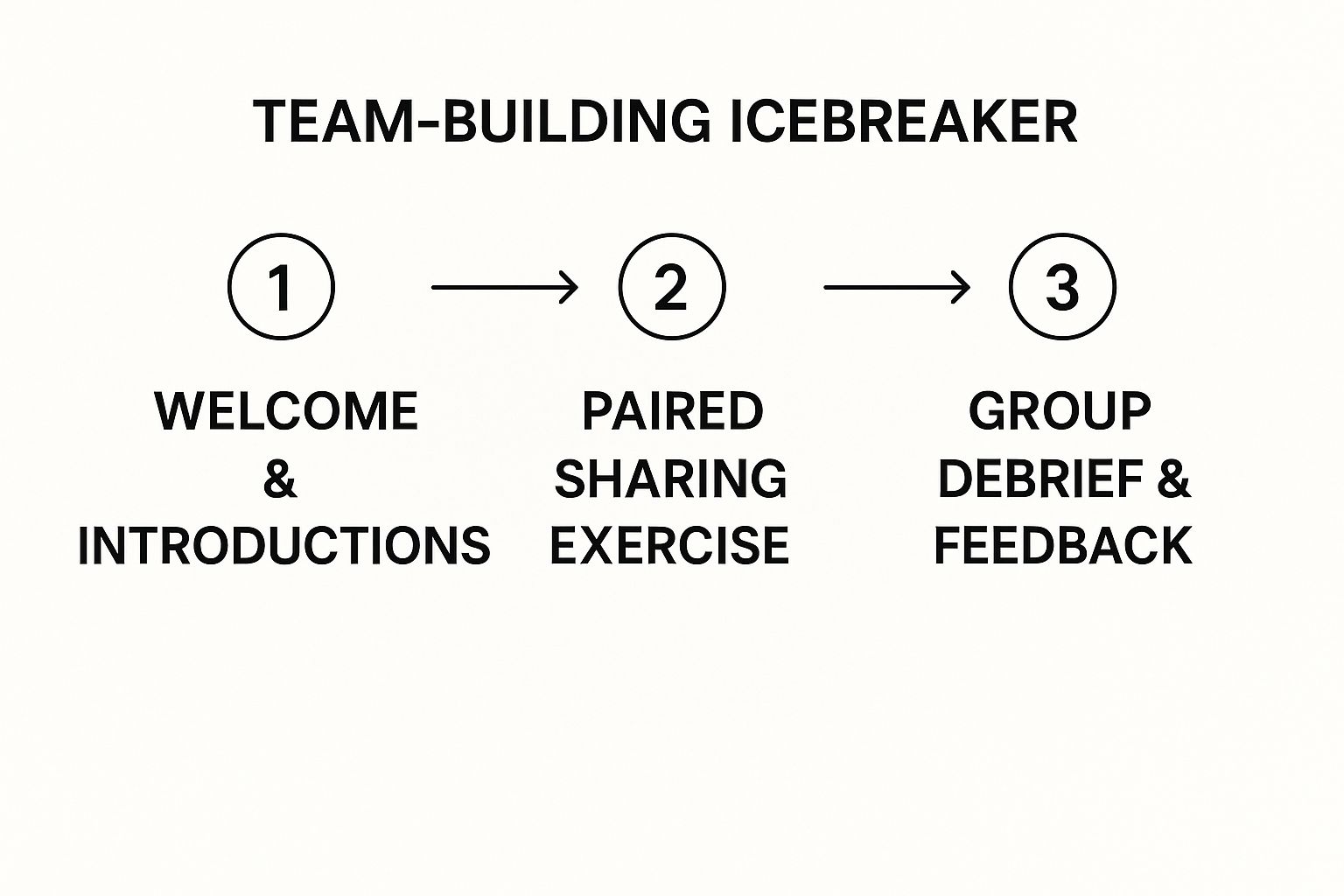
This image shows how even a simple icebreaker has a clear, effective structure. It moves from an individual introduction, to sharing in pairs, and finally to a group reflection. This kind of intentional flow ensures that every activity, no matter how small, is focused and contributes to the workshop’s bigger purpose.
How to Design an Engaging Agenda
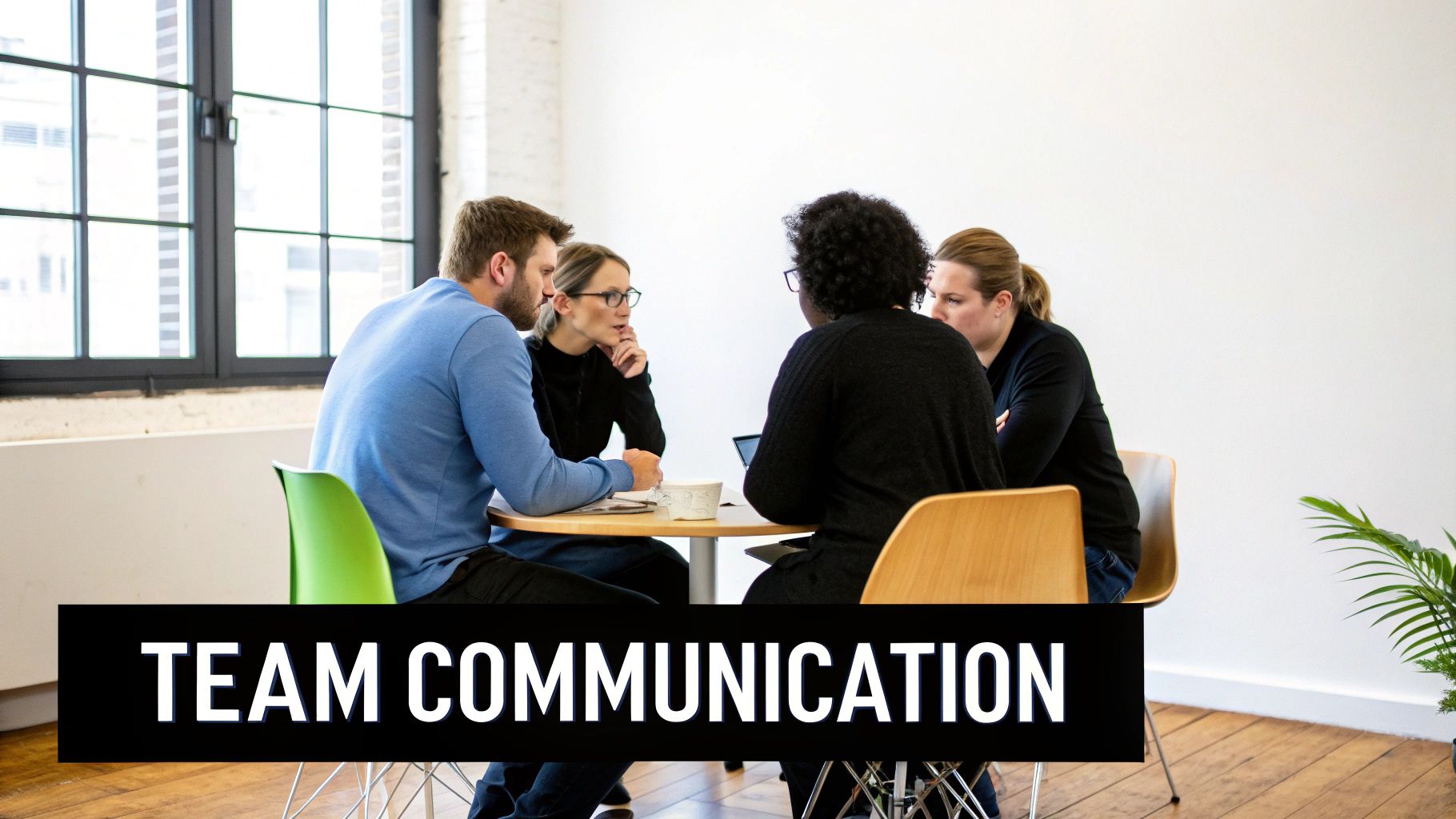
The agenda is what separates a truly great workshop from a random collection of activities. I like to think of it as the story arc of the day—it needs a strong beginning, a compelling middle, and a satisfying conclusion. Without that deliberate flow, even the most creative exercises can feel disjointed, leaving your team feeling more drained than inspired.
So, your first step is to step back and think about the rhythm of the event. A good workshop has a natural pulse. It usually starts with something that breaks the ice and sets the stage, moves into the core "work" sessions, and then wraps up in a way that cements the day's wins.
✦Balancing Structure and Social Time
I've seen so many well-intentioned workshops fail because they were over-scheduled. It's a classic mistake to pack every single minute with structured activities. People need downtime to process what they’re learning and, just as importantly, to connect with each other on a human level.
Honestly, some of the most valuable breakthroughs happen during the coffee breaks or over lunch. Those informal chats are where genuine team rapport is built.
A good rule of thumb is the 80/20 principle. I try to dedicate about 80% of the schedule to structured, goal-focused activities. The other 20% is reserved for informal social time and breaks. This gives you the best of both worlds: you stay on track with your objectives while still creating space for those crucial, unscripted moments of connection.
✦Sample Agenda Flows
Of course, the perfect agenda flow depends on how much time you have. A half-day virtual session will feel very different from a full-day, in-person event.
Here are a couple of examples I've used successfully:
- Half-Day Virtual Workshop: Jump in with a quick, high-energy icebreaker to get everyone logged in and talking. Dive into your main problem-solving session, but be sure to schedule a 15-minute bio-break. You can’t skip this online. Finish with a solid group reflection and a clear "what's next" discussion.
- Full-Day In-Person Workshop: Ease into the day with welcome coffee and casual intros. I like to use the morning for a big, hands-on collaborative challenge. After a real lunch break (get them out of the main room!), the afternoon can be focused on skill-building exercises. Capping it off with a relaxed social hour is always a great touch.
My pro-tip: Always plan for a short "energizer" activity to fight off that post-lunch slump. It can be a simple 5-minute game or even just a group stretch. It sounds small, but it completely resets the energy in the room and keeps people focused.
✦Building Momentum from Start to Finish
A great agenda builds momentum. You want to start with activities that are fun, low-risk, and get people comfortable. This creates a sense of psychological safety right from the beginning. Once that trust is established, you can gradually move into more complex or even more vulnerable exercises later in the day.
And please, end on a high note. The final session is your chance to bring everything together. It should summarize the key insights and define clear, actionable next steps. You want every single person to walk out of that room feeling like they accomplished something, feeling more connected to their team, and knowing exactly how they'll use what they learned back on the job. That’s how a one-day event becomes a long-term win.
Using Slack and Google Calendar to Streamline Your Workshop Planning
For any company that runs on Slack and Google Calendar, planning a team building workshop can feel disjointed. You create the event in Google Calendar, then switch over to Slack to announce it, share the details, and chase down RSVPs. This constant back-and-forth between platforms is inefficient and often leads to missed information and low attendance.
What if you could bridge that gap? Imagine managing your entire event workflow—from the initial Google Calendar invite to the final Slack reminder—from one central place. This is how you stop the administrative drain and get back to designing an amazing experience.
✦Why Integrating Your Tools Is a Game-Changer
The real magic happens when your core tools work together seamlessly. For a company that relies heavily on Slack for communication and Google Calendar for scheduling, a native integration isn't just a convenience—it's a massive productivity boost. It eliminates the tedious copy-paste routine and ensures everyone is on the same page.
Here’s how it works in practice when you're planning a workshop:
- You create the event in Google Calendar, just as you always do.
- Instantly, a professional-looking announcement is posted in your chosen Slack channel.
- Team members see all the key details and can RSVP with a single click, right inside Slack.
- Those RSVPs are automatically synced back to your Google Calendar event.
This unified approach creates a single source of truth for your event, minimizing confusion and making life easier for everyone.
By meeting your team in the tool they use all day, every day, you remove the friction from the event process. When everything is centralized in Slack, it becomes incredibly simple for people to stay informed and get involved.
✦The Easiest Way to Connect Slack and Google Calendar
This is precisely the problem a tool like Be-there.co solves. It's built to be the essential bridge between Slack and Google Calendar, making it the perfect companion for any company that uses both. It transforms how you manage internal events, handling everything from announcements to attendance tracking, all without leaving Slack.
Here’s an example of an event announcement created with Be-there.co. It's posted directly into Slack with a custom image, clear details, and interactive RSVP buttons.
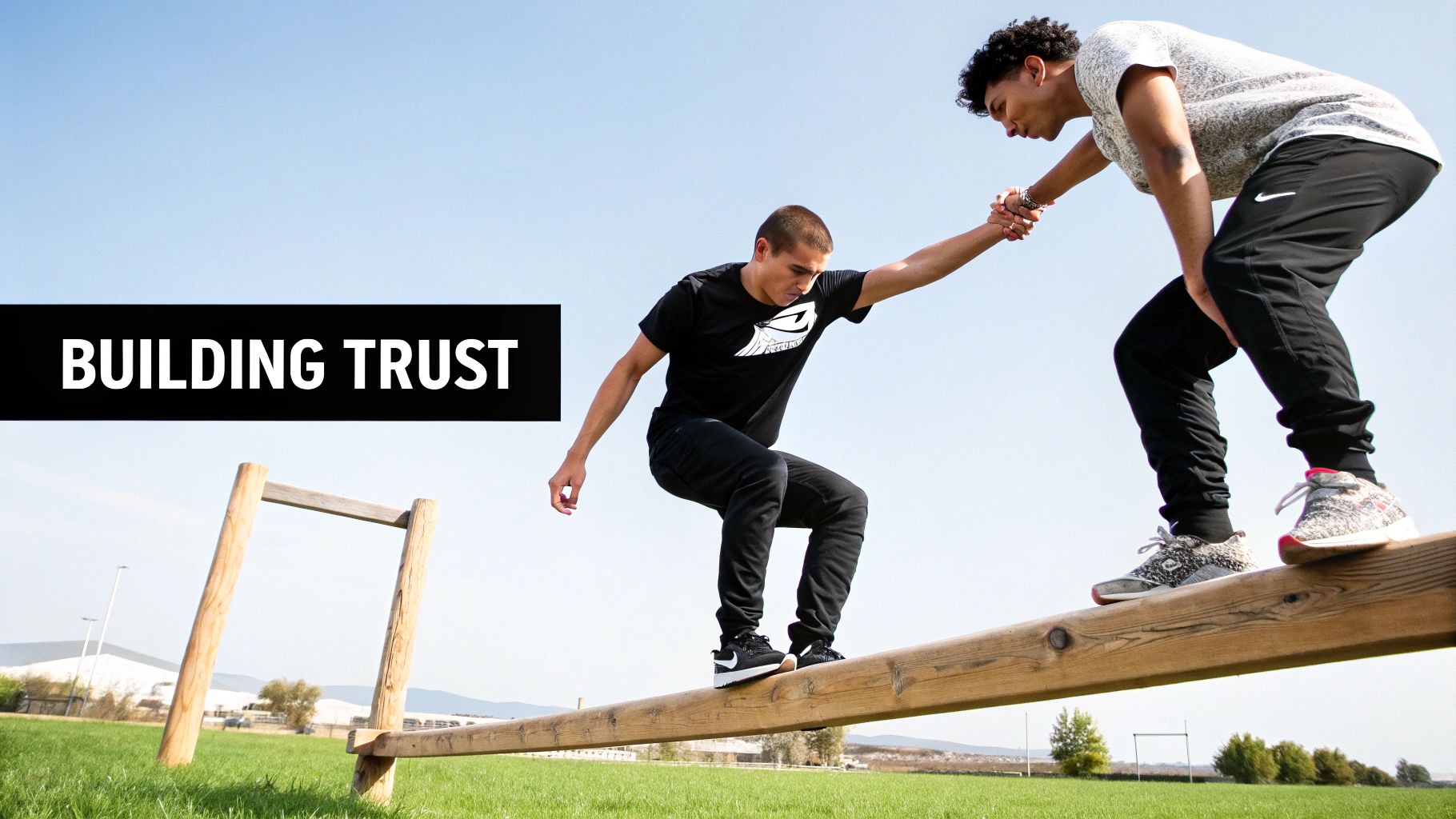
This streamlined system does more than just look good. It automatically sends reminders, syncs attendance back to Google Calendar, and centralizes all event-related conversations. The result is consistently higher engagement and better turnout. It also empowers you to create more exciting posts, which helps build genuine anticipation for your workshop.
By automating the logistics, you can focus your energy on what truly matters: creating a valuable and memorable workshop. For an even more optimized workflow, you could use an AI for Google Calendar to find the best time for everyone before creating the event. Combining smart scheduling with seamless, integrated communication is the key to a flawless planning experience.
Getting People in the Door and Proving It Mattered
You've planned the perfect workshop and the agenda is killer, but there are two final hurdles to clear. First, you need to get people genuinely excited to show up. Second, you have to prove the event was worth the time and investment. Neither of these happens by just sending a calendar invite and hoping for the best.
So, how do you build that pre-event buzz? It starts with how you talk about it. Ditch the dry, corporate-sounding announcements. Instead, drop some teaser messages in Slack that focus on what your team will actually get out of it. Will they learn a new way to tackle tough problems? Or maybe just get a paid break from the usual routine to actually connect with their colleagues? Focus on the why, not just the what.
✦Moving Beyond a Simple Headcount
Once the workshop is over and everyone's logged off, your job shifts to figuring out what actually changed. This is where you connect the fun and games to real, tangible business results. The goal isn't just to ask, "Did you have a good time?" It's about understanding the workshop's true impact on how your team functions.
Getting this feedback doesn't have to be a drag. Post-event surveys are your best friend here, but don't just throw a boring 1-10 rating scale at people. Get creative. Ask them to describe the day in three words, or use a fun emoji scale. You want honest, specific feedback you can actually use to make the next event even better.
By mixing these qualitative insights with hard numbers, you can tell a much more powerful story. You’re not just showing leadership that people had fun; you're showing them that the workshop directly improved collaboration, communication, and the bottom line.
✦Calculating the Real ROI of Your Workshop
Let's be honest: you’ll need to justify the budget for the next one. The good news is that proving the return on investment (ROI) for team building is more straightforward than ever, especially with virtual and hybrid events. For example, virtual team-building activities can cost up to 75% less per person and deliver a 12% higher ROI than their in-person counterparts, according to one report on the financial impact of team building.
The trick is to track the right things. Keep an eye on a few key metrics in the weeks after your workshop. You might look for things like:
- Productivity Metrics: Did the team’s output or efficiency tick up?
- Project Timelines: Are those tricky cross-functional projects suddenly running a bit smoother?
- Employee Feedback: Are you noticing more positive comments in your regular pulse surveys?
This data helps you draw a straight line from the workshop to your company's bigger goals. If you want to go even deeper on this topic, check out our guide on how to measure employee engagement. When you can connect your event to these critical business metrics, you’re not just proving its value—you’re building an undeniable case for doing it again.
A Few Common Questions You'll Probably Ask
Even the most seasoned planners hit a few snags when putting together a team building workshop. Let's walk through some of the questions that pop up time and time again, so you can handle them like a pro.
✦What's a Realistic Budget for This?
This is the big one, isn't it? Everyone wants a magic number, but the truth is, it doesn't exist. Instead of focusing on the bare minimum, I always tell people to reframe the question: "What's the best possible experience we can create with the budget we have?"
This simple shift moves you from a scarcity mindset to one of creativity. A cheap, thrown-together event can do more harm than good, leaving people feeling undervalued. But a well-thought-out workshop, even on a smaller budget, can be incredible. Think about tapping into in-house talent to lead a session or partnering with a cool local spot instead of a sterile conference room. You’d be surprised what you can pull off.
✦How Do I Keep Our Remote Folks from Zoning Out?
Ah, the virtual engagement puzzle. You can't just point a camera at the in-person event and call it a day. Remote team members need to feel like active participants, not just spectators.
Here are a few things that have worked for me:
- Embrace Breakout Rooms: Seriously, use them often. Small groups force interaction in a way that a main room with 30 faces on screen never will. Just make sure you give each group a crystal-clear task and a deadline.
- Bring in the Tech: Tools like Miro for virtual whiteboarding or Slido for live polls are fantastic. They give everyone, regardless of location, a way to contribute their ideas at the same time.
- Designate a Virtual MC: Have someone whose only job is to advocate for the remote crew. They'll monitor the chat for questions, make sure virtual hands are seen, and chime in to ensure the conversation isn't dominated by the people in the room.
✦How Long Should This Workshop Actually Be?
The right length is all about your goals. Don't book a full day just because it feels "official."
If you're trying to nail down a new team process or solve a specific problem, a sharp, focused half-day (think 3-4 hours) is perfect. If you’re looking to build relationships and dive into bigger-picture strategy, a full day can work wonders, as it gives you breathing room for more social, unstructured time.
Multi-day events? Save those for the big annual offsites. At the end of the day, a tight, high-impact workshop will always beat a long, meandering one. Respect people's time, and they'll give you their full attention.
Never forget why you're doing this. The ultimate goal is to build a more engaged team, and the payoff is huge. Highly engaged teams can drive up to 23% higher profitability and are far less likely to leave. Keep that in mind as you iron out the details.
If you're curious, you can learn more about how workplace collaboration impacts the bottom line.
Ready to get your next company event on the calendar? Be There is the easiest way to do it. You can create and send beautiful event announcements right inside Slack, sync everything to Google Calendar, and track RSVPs without the headache. Give it a try for free at https://be-there.co.

Planning your internal events has never been easier!
No more scheduling headaches—our Slack-connected web app keeps things simple. Less email, more fun! 🚀
